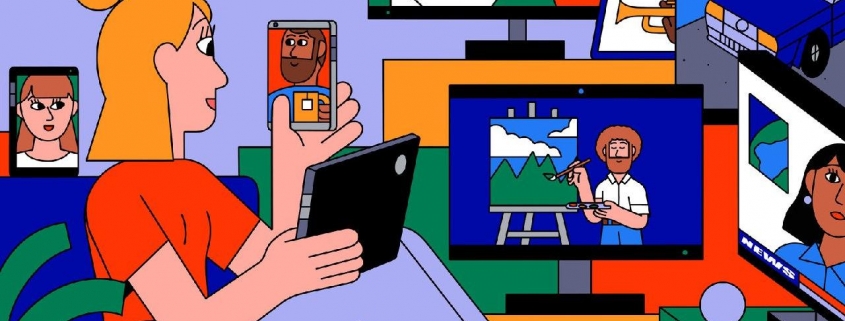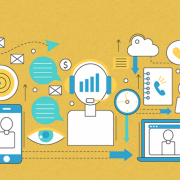Effective Screen Time While Working from Home
Before the quarantine, most of us likely thought that we have spent almost all of our workday at the computer. But little did we know that you could spend so much more. Between commutes, meetings, chats, watercooler talks, coffee breaks, and lunches, we had many opportunities throughout the day where our eyes would have less screen time and detach from the digital realm.
Now with those natural breaks eliminated, there’s little to no break from the connection to technology. In particular, video calls add an extra layer of fatigue. Having to focus on multiple faces simultaneously while also being conscious that everyone can see you creates an added layer of mental and emotional exhaustion that wouldn’t be experienced as acutely in an in-person setting. The extra time in front of the computer can also cause eye strain and muscle fatigue because you need to hold your body rigid for hours to stay inside a camera’s range.
A recent study found that the average office worker spends 1,700 hours per year in front of a computer screen — and that was before many of us began working from home. Add to that our frequent use of phones and other digital devices, and you’ve got a recipe for unhappy — and possibly unhealthy — eyes. What are the implications for the eyes during this period of greatly increased screen time?
When we’re moving between meetings and offices and interacting with people face-to-face, it’s a simple fact that we move our eyes more. We blink more, which helps keep the eyes lubricated and comfortable. But when we look at a screen for extended periods, we tend not to blink. In fact, focusing the eyes on computer screens or other digital displays has been shown to reduce a person’s blink rate by a third to a half.
According to Esen Akpek, professor of ophthalmology at Wilmer Eye Institute, Johns Hopkins Medicine and an expert in dry eye, not only does extensive gazing — such as that which occurs when reading on a computer screen — dry the eyes, it also starts a vicious cycle. “When your eyes become dry, that reduces reading speed, which further increases exposure time and worsens dryness,” Akpek has said, “and this can ultimately lead to inflammation of the eye surface and a self-perpetuating chronic dry eye.”
Gone are the days when we could break away from our computers with post-work pub trips, theatre visits, or meals out. Work events and conferences, too, once provided a much-needed respite from staring at displays all day, while meetings could be conducted device-free and in-person. Due to ongoing lockdown measures to combat the COVID-19 pandemic, however, we’ve come to rely on screens more than ever; not just for work, but to keep our social lives going, too.
In order to help your time management and regain energy, there are ways that can reduce or eliminate technology throughout the day. Here are a few tips and tricks that have been proved to be most effective.
Limit meeting duration
Normally, setting aside blocks of time to get work done is a good idea. But if you find virtual meetings draining, this practice is even more essential for you right now. Block out time on your schedule where you’re not available for meetings so that you can temper how much virtual communication you have each day. That could look like setting aside most of a morning or afternoon as a meeting-free time or blocking out a few one-hour chunks of time throughout the day to detach and focus on other work.
More physical less digital
In order to balance out the increased screen time both on and off the clock, look for ways that you can take the low-tech route. Brainstorming for an article? Write out your thoughts on paper. Creating a road map for a big project? Sketch the initial draft on a white board. Reading a book? Pick up a print copy. Exercising? Go outside on a run. Anytime you can reasonably choose a physical option over a digital one, take it. Stepping away from the computer not only offers you a digital break, but can help you be more creative.
Get up and move
To cancel out the fatigue caused by sitting rigidly in front of your computer, move around as much as you can. In between meetings, take a walk to the kitchen to refill your water or coffee. When you need a quick break, do a few simple movements like rolling your shoulders to get the blood flowing. If you have a standing desk, move it up and down so you’re able to both sit and stand throughout the day. If you don’t have a standing desk, put your computer on a high counter or bureau to get an opportunity to stretch your legs. And if you’re on a normal phone call and don’t need to be taking notes or looking at documents while you talk, consider standing up or even walking back and forth during the conversation.
Activate the blue-light filter on all of your devices
One of the most effective ways to immediately reduce eye strain is by installing a filter that warms the tone of your display. Although the eyes absorb blue light naturally, prolonged exposure from computer displays can lead to eye strain, according to Prevent Blindness. The consequences include irritation as well as difficulty focusing.
There are a number of free tools out there, including f.lux and the open-source Lightbulb, which users can download immediately in order to modify the tones on their displays. macOS and Windows 10 users can also opt to make use of night-time filters bundled into their operating systems. These can be found under display settings in each OS and can be activated throughout the day if needs be, not just at night.
Tech-free breaks
Although it may feel more “efficient” to eat lunch at your computer, your brain will thank you for taking a break from the screen. Eat lunch while chatting with your family members in the kitchen, looking out a window, or reading a physical book. Stepping away from technology not only gives your brain a break but also gives you the added bonus of perspective. I find that even when I take a short lunch of 15 to 20 minutes where I simply eat without doing anything else, I feel more peaceful at the end than I did before. I also find that I tend to have a clearer sense of the big picture of what’s occurring in my life and work.
Another practice that’s benefiting myself as well as many of my time management coaching clients is post-work outdoor physical activity. This includes taking a walk, playing basketball in a driveway, gardening, or anything else that gets you active. This split from the digital world refreshes your brain and helps to create some separation from the end of your work day and the beginning of your personal time.
Don’t e-socialise right after working hours
In the last few weeks, we’ve been forced to find increasingly creative ways to stay in touch with our friends and loved ones – whether on Zoom, Skype, Google Meet or Google Hangout.
Just as you wish to break up your working day, it’s important not to hop straight from work to online catchups, however. You should leave a little room for a break to reduce the strain on your eyes, perhaps by getting up for a short walk, making a snack, or catching up with the people you live with. Try to leave yourself a little breathing room in the schedule while organising your digital commitments to ensure you aren’t glued to your computer, tablet or smartphone all morning.
Take up a new hobby
Besides saving time on travel, lockdown has freed up dozens of hours per week that would have otherwise been spent on going out or meeting up with people in-person. While this is the perfect time to catch up on boxsets, or the latest shows that have passed us by, it’s critical we don’t fill all these hours up with yet more screen-related activities.
It could be the best time to engage in a long-lost passion, learn how to cook, or take up more exercise. There are hundreds of activities you can take up now and then throughout the lockdown period to ensure you’re keeping yourself entertained while resting your eyes after a day locked to your computer. This may also help to more effectively maintain a work-life balance, with these lines threatening to become intertwined very easily.
When it’s possible to go back to more in-person communications, it will be a wonderful relief. But in the immediate term, some of the added digital load is unavoidable. These strategies can help you counter that load and reduce digital fatigue.
Given our current situation knowing that your colleagues or employees are best suited for this new scenario we find ourselves in. Finding the right talent, the best fit for the job and your organisation can be a very challenging task. It is now important to find out whether your managers or your team is well-equipped of working together from various locations. It requires deep knowledge of their personalities, strengths, weaknesses, interests, work style and other characteristics. Our technology and solutions will do the work for you, helping you discover if your people are resilient during times of hardship, if they are autonomous, if they are team players, without actual human contact. Given that our platform is cloud-based, everyone can use it from home as well. Humanity finds itself at a crossroad for various reasons now, why not help people discover and develop themselves from the comfort of their own homes?
Request a free demo:

Sources:
https://www.itpro.co.uk/business/business-strategy/355372/8-tips-for-reducing-screen-fatigue-while-working-from-home
https://www.hopkinsmedicine.org/news/articles/protect-your-eyes-from-screen-time
https://hbr.org/2020/05/5-tips-to-reduce-screen-time-while-youre-wfh











